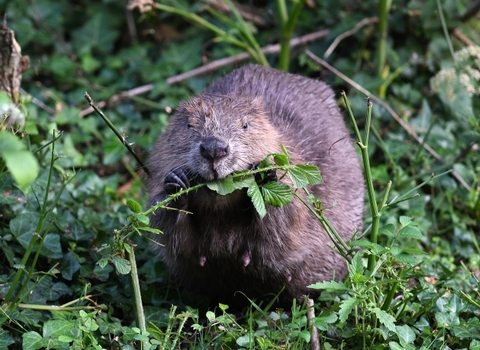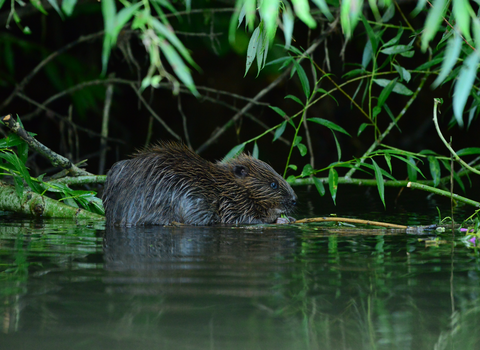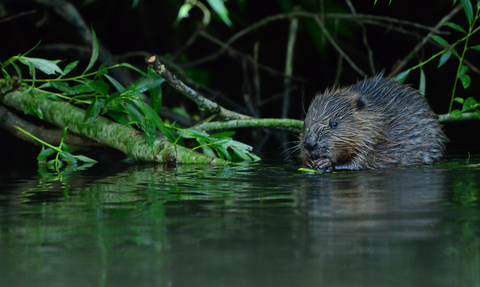
(c) Bevis Watts
Beaver Advice and Support
Supporting our wild beavers
Since the first sightings of Eurasian beavers on the River Avon in 2021, there has been growing evidence that a healthy population of wild living beavers has made this part of the South West their home. We don't know where the beavers in our area came from, but it is likely that they result from one or more unofficial releases.
Over the last 15 years licensed beaver reintroduction programmes have involved releases into managed enclosures. However in February 2025, the Government issued a new policy paper which permits licensed wild releases outside of enclosures in England. These wild releases will require funding to be in place to support communities, farmers and landowners through the process of beavers returning to the landscape.
The lack of a planned and funded release project in the Bristol Avon and Somerset Frome catchment means that the wild beavers in our area are largely unsupported from a management and monitoring perspective. This has left farmers and landowners in a difficult position, with minimal support as they learn how to live alongside this returning species.
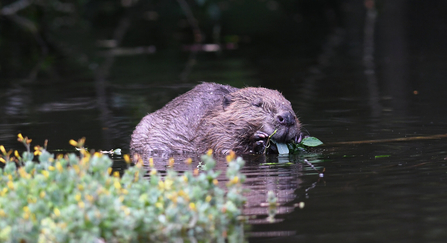
David Parkyn - David Parkyn/ Cornwall Wildlife Trust
What support is Avon Wildlife Trust offering?
Over the last four years, the members and supporters of Avon Wildlife Trust have given generously to several Beaver Appeals. The funds raised have enabled us to offer some on-the-ground support to those living alongside beavers. We are delighted to be able to upscale this work thanks to funding from The Wildlife Trusts, and in April 2025 we launched our new Beaver Advice and Support Team (Bristol Avon & Somerset Frome).
Running for 18 months, this project provides vital, active support in the early stages of beaver recolonisation in the region.
With a small team of trained, licensed practitioners, we provide advice and support to farmers, landowners and communities who are living alongside wild beavers. We also work with a panel of expert representatives from eNGOs, statutory bodies and the public sector to share learnings and expertise in our region. Our aim is to ensure that anyone who comes into contact with beavers, or finds beavers living on or around their land, can access the necessary support and advice in order to live harmoniously together.
A concise guide to managing beaver activities can be found here
If you are a farmer or landowner with a beaver on or around your land, and would like any advice or guidance, please tap the link below to email us
alex.preston@avonwildlifetrust.org.uk
If you have a general enquiry about beavers and would like to contact the team, please tap the link below to email us
Spotter's guide - What are the signs of beavers?
- Gnawed wood – look out for wood that's been chewed, with signs of tooth marks and sometimes woodchips on the ground.
- Pencil tip – a log or branch gnawed to a point is a sure sign there are beavers about.
- Dam – made of sticks, mud and vegetation. Usually on smaller streams and ditches rather than our larger rivers.
- Burrow in the riverbank – particularly visible when the river is low.
- Footprint – beaver footprints are large and long although they can be hard to spot. A clear print will display the outline of the web of skin connecting the toes.
- Beaver lodge - a large pile of branches beside a watercourse can be a sign that a beaver is in residence, although sometimes this can just be flood debris.
Log your beaver sighting
Please help us monitor the population by recording any signs of beavers you see using the form below, making sure to press 'Submit' at the end.
Why are beavers great for Avon?
Bristol City and Bath and North East Somerset councils have both declared ecological and climate emergencies, signifying an urgent need for action.
We are now at crisis point and must find ways to promote an abundance of wildlife whilst also reducing the risk of flooding, tackling drought, and decreasing the levels of pollution.
Beavers are nature's engineers and could be part of the solution to these challenges, which is why we're so excited that they are now living wild here in Avon. Over time, beavers will help to create thriving, carbon-absorbing habitats along the waterways they inhabit. Read on to find out about all the different benefits which beavers can provide.
Reduce flooding
Their dams protect against flooding, easing pressure downstream by slowing the flow of water. For example, a single five-acre beaver enclosure in Cornwall decreased peak flows following high rainfall events by 50%, greatly reducing the flood risk in the village downstream.
Prevent drought
Their dams help with drought by storing water. This significantly reduces the impact of higher summer temperatures on surrounding habitats, by being a source of water for land managers and wildlife throughout periods of drought. This will be particularly beneficial since our summers are predicted to become warmer and drier due to climate change.
Carbon storage
The dams hold back silt which captures carbon, while the new plant growth which is created by their efforts provides a fantastic carbon sink. Again, this can help reduce the impact of climate change.
Clean water
By filtering out sediment and pollutants such as fertilisers and pesticides used by farmers, the dams reduce pollution and clean our water supply.
Plant biodiversity
Beaver activity can boost plant diversity by as much as 33%. By gnawing down trees to create their dams, beavers coppice the woods around them. This encourages new growth among light-seeking plants and increases the diversity of woodland habitats.
Other wildlife
There is an increase in the abundance and diversity of all species in areas affected by beavers. For example, the deep ponds which beaver dams create provide new habitats for a range of fish, invertebrates and other species. Meanwhile, the wetlands they encourage are a haven for birdlife and the debris from their building work attracts a host of invertebrates, a vital part of the food chain.
Where they live
David Parkyn/Cornwall Wildlife Trust
Avon’s wild beavers have set up home within the region's waterways, although for their own safety their exact locations are a closely guarded secret.
Beavers have been spotted in several places along the Bristol Avon and Somerset Frome, so you stand a chance of seeing one whenever you’re out walking along the river. The ideal habitat for beavers would be a patch of woodland surrounding a source of fresh water like a stream or ditch network. Their hearing is excellent, but their eyesight is poor, so they usually stay within 20 metres of water.
If you do spot a beaver in the wild in Avon, we'd love to know! Simply complete the form above to let us know where you've seen them.
Follow the beaver code
When watching beavers, please remember they are sensitive wild animals. Please follow the Beaver Trust’s Beaver Code:
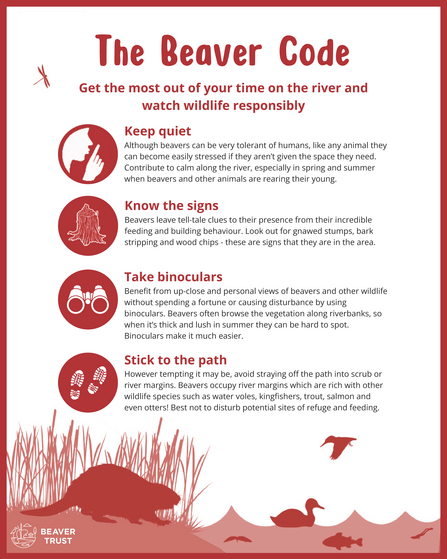
The Beaver Code (C) Beaver Trust
Frequently asked questions
What is a keystone species?
Beavers are often described as a keystone species. This is a species which plays a unique and critical role in the way an ecosystem functions, or in the structure and health of a habitat. The presence of keystone species determines the types and numbers of other species found in that environment. Without keystone species, the habitat is dramatically different, usually far less healthy, and in some cases, ceases to exist. An analogy is the keystone in a brick arch. If you remove the keystone then the arch collapses. When beavers were removed from Britain, the habitats they supported collapsed.
Do beavers cause environmental damage?
Beavers do modify the habitats and landscapes they live in through coppicing, feeding and in some cases damming (beavers living on lakes or large rivers have little need of constructing dams). In the first instance, these changes can markedly alter the appearance of the local environment but all of these modifications have a positive effect on biodiversity.
Beaver adaptations can bring enormous benefits to other species, including otters, water shrews, water voles, birds, invertebrates especially dragonflies, and breeding fish. In effect, beavers naturally create and maintain diverse habitats. Their dams can hold water in periods of drought, can regulate flooding and improve water quality by holding silt behind dams and catching acidic and agricultural run-off.
Beavers forage close to water with activity usually concentrated within 20m of the water’s edge. Beavers do fell broad-leafed trees and bushes in order to eat the bark during the winter and to construct their lodges. Most trees will be coppiced and will regenerate, which diversifies the surrounding habitat structure. Coppicing has been practiced by foresters throughout history as a method to manage bankside trees. The actions of beavers are very similar meaning the woodlands will be naturally maintained.
Beavers occasionally require direct management, if their activities result in undesirable localised flooding or tree felling. Any occasional localised problems are usually overcome by simple actions, such as dam adjustment or removal and fencing.
Note that beavers are a protected species and carrying out these actions may in some circumstances require a licence, so appropriate advice should be obtained before carrying them out.
Do beavers cause damage to farmland and the wider countryside?
Evidence from Europe shows that shows that beaver damage is, in the vast majority of cases, small-scale and localised. Beavers are not regarded as pests in Europe and where localised problems have occurred, there are a number of well-established methods in place. These include the removal of dams, the introduction of overflow piping, or the installation of fencing (as one does for deer and rabbits). These management methods may in some cases require a licence from Natural England. The Beaver Advice and Support Team provides farmers and landowners with support and advice - see contact details above.
Do beavers pose a flooding threat?
In general, beavers can actually help reduce the risk of flooding lower down in river systems by building dams and moderating water flow. The modifications which beavers make to streams can raise the water table locally, creating wetland areas and benefiting biodiversity. Evidence from elsewhere in Europe shows that instances of beaver dams creating undesirable flooding are uncommon, localised and usually small-scale. In these situations, dams are simply removed or pipes (‘beaver deceivers’) are placed through them to manage water levels.
It is important to differentiate between the storage of water by beavers in river headwaters, and the impact of beavers on low lying land. In some places, culverts and drainage systems, some of which are critical to reducing flood risk, need to be kept clear of beaver debris.
The Beaver Advice and Support Team can provide farmers and landowners with support and advice on managing unwanted beaver dams – see contact details above.
Do beavers eat fish?
No. Beavers are completely vegetarian. Beavers eat woody plants and bark, aquatic plants, grasses and shrubs.
Do beavers affect fish species?
Beaver activities may have both positive and negative impacts on different fish species. Understanding the overall impact is complex. Beaver dams may act as barriers to migratory species such as salmon in some years and conditions, and cause localised siltation upstream of dams affecting spawning habitat. On the other hand, positive impacts may include an increase in habitat for fish rearing and overwintering, an increase in refuge areas during high and low flow periods and an increase in aquatic invertebrate prey species. Read more about the potential impact on fish by the Scottish Wildlife Trust.
Do beavers prefer certain tree species?
Beavers have a definite preference for certain trees. Preferred tree species include alder, aspen, apple, birch, cherry, cottonwood, poplar and willow. Aspen/poplar and apple are their favourite. If the supply of their preferred trees is low, they will feed on oaks and some maples.
Conifers such as pines, hemlocks, etc. are their least favourite. Sometimes they will girdle (remove the bark around the entire base) conifers for an unknown reason. One possibility is to obtain a much-needed dietary nutrient.
What impact do the beavers have on water quality and hydrology?
Research suggests that ponds and pools created by beaver dams can have marked benefits for local water quality. Dams are usually only built on small streams, less than 3 metres wide, and these can moderate the detrimental effect of irregular flow. The modifications can also raise the water table locally creating wetland areas to the benefit of biodiversity.
The ponds can help to neutralise acidic run-off, act as sinks for pollutants and increase the self-purification of a watercourse. They can form considerable sediment traps, reducing very strongly erosive runoff and particulate loads in downstream water.
Do beavers carry disease?
Beavers can carry host-specific parasites, though these are not known to infect or harm other species of wildlife, livestock or humans. Other parasites carried by beaver are already present in British wildlife, livestock and humans.
Can we see beavers?
Beavers live in burrows dug into river and pond banks. They sometimes live in lodges built out of sticks and mud. They are mostly nocturnal (i.e. active at night). They can be seen emerging or returning to their lodges at dusk and dawn, times when they are actively feeding, grooming and patrolling their territories.
What is the current status of beavers in Great Britain?
Beaver reintroduction in Great Britain is a devolved matter. As such, the status of beavers in Scotland, England and Wales is devolved to each respective government and reintroduction is at differing stages across these nations.
There currently is no known evidence of beavers ever having been present in Northern Ireland (or the Republic of Ireland). As such, no beaver introduction projects are due to take place there.
ENGLAND: The River Otter Beaver Trial was a licenced five year reintroduction trial that took place in Devon. In August 2020 the Government announced that Devon's beavers could stay. This was the first legally sanctioned reintroduction of an extinct native mammal to England. It meant that the beaver population, which lives on the River Otter, now has a secure future. There are also a number of fenced beaver projects across the country, including in Cornwall, Yorkshire and Essex amongst others. On 1 October 2022 the legislation changed to protect wild-living beavers in England, making them a 'European Protected Species' and classifying them as a native animal. Beavers are now protected under the Conservation of Habitats and Species Regulations 2017 which means it is an offence to deliberately capture, injure, kill or disturb beavers, or damage and destroy their breeding sites or resting places without a wildlife management license from Natural England. In February 2025 Natural England set out a framework for beavers to be released into the wild under licence.
SCOTLAND: For the latest news on beavers in Scotland, please visit the Scottish Wildlife Trust.
WALES: For the latest news on beavers in Wales, please visit the Welsh Beaver Project.
Where have Avon's beavers come from?
The origins of Avon’s wild beaver population are a mystery. Possibilities include escapees from other releases, which have occurred across the South West since the early 2000s. We started receiving sightings around 2021, and our subsequent monitoring told us there are 3 generations of beavers living on the riverbank. This suggests they have been happily co-existing alongside humans for some years.
'River Journey' beaver footage (https://youtu.be/jqYw4WaCQqg)
(C) Bevis Watts
Stay in touch
To stay up to date with what's happening with Avon's beavers as well as other projects from across Avon Wildlife Trust, sign up to our email updates.

Ecological Restoration Fund logo





